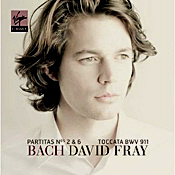 Austrian Max Steiner (1888-1971) wasn’t always the great
movie-score composer he became; it took him a while to become known as the
“father of film music.” He worked on Broadway for years as a musical arranger,
orchestrator, and conductor before coming to Hollywood in 1929 and registering his
first big hit with King Kong (1933),
which thanks to Steiner became one of the first films to use an extensive,
original, scene-specific musical score. After that, Steiner went on to do
practically every big picture Warner Bros. and MGM made in the Thirties,
Forties, and Fifties--movies like The
Informer, Now Voyager, Jezebel, The Charge of the Light Brigade,
The Treasure of the Sierra Madre,
Casablanca, The Searchers, and Gone with the Wind--finally winding
down his career in the early Sixties.
Austrian Max Steiner (1888-1971) wasn’t always the great
movie-score composer he became; it took him a while to become known as the
“father of film music.” He worked on Broadway for years as a musical arranger,
orchestrator, and conductor before coming to Hollywood in 1929 and registering his
first big hit with King Kong (1933),
which thanks to Steiner became one of the first films to use an extensive,
original, scene-specific musical score. After that, Steiner went on to do
practically every big picture Warner Bros. and MGM made in the Thirties,
Forties, and Fifties--movies like The
Informer, Now Voyager, Jezebel, The Charge of the Light Brigade,
The Treasure of the Sierra Madre,
Casablanca, The Searchers, and Gone with the Wind--finally winding
down his career in the early Sixties.
In this 2-disc set Steiner wrote the main selection, Adventures of Don Juan, for Errol
Flynn’s 1948 tongue-in-cheek swashbuckler. The album’s producers--Anna Bonn,
John Morgan, and William Stromberg--have reassembled the complete score for the
film and present it in thirty-three tracks in another meticulous release from
Tribute Film Classics. They even provide a bonus trailer track. Movie fans,
film-music fans, as well as classical music fans in general will all enjoy the
results.
It had been a full decade since star Errol Flynn made “The
Adventures of Robin Hood,” and by 1948 due to hard drinking and riotous living
the actor’s health and career had fallen into decline. Still, thanks to a
cheeky screenplay by George Oppenheimer and Harry Kurnitz from a story by Herbert
Dalmas (with uncredited assistance from Robert Florey and William Faulkner of
all people) and fairly lively direction by Vincent Sherman, the movie made a
welcome throwback to Flynn’s earlier swaggering movie roles.
Appropriate to a film about the legendary Spanish nobleman
famous for his uninhibited lifestyle and many seductions, Steiner wrote a score
that takes full advantage of situation. The music is dashing, heroic, Romantic,
exciting, sentimental, suspenseful, and serene by turns. Perhaps it is no
coincidence that Steiner’s godfather was, literally, Richard Strauss, whose Ein Heldenleben, Till Eulenspiegel, Don
Quixote, and, especially, Don Juan
probably inspired the younger composer.
Co-producer John Morgan reconstructed and orchestrated a
number of musical cues that hadn’t survived the sixty-odd years since Steiner
first wrote them, so we welcome them. What’s more, the “London Processional”
track sounds especially appealing, and audiophiles might want to single it out
for demo purposes
When I first heard William Stromberg leading the Moscow
Symphony Orchestra in movie music back in the days when they recorded for Marco
Polo and Naxos, I was a little suspicious. How would a Russian orchestra do
playing Hollywood movie scores? It didn’t take me long to realize they handled
the music splendidly, and the conductor and orchestra have only gotten better
with time. The Moscow forces play with a style and flair worthy of any
Hollywood studio orchestra, but they add further polish, resonance, and richness
to the equation.
 In addition to Adventures
of Don Juan, the set includes Steiner’s complete score for the 1944 Cary
Grant black comedy Arsenic and Old Lace
(eleven tracks). Here, almost all of the musicians’ prepared parts survived the
years. Needless to say, the music is delightful. Then, too, we also get an
additional alternate track, “Baseball a la Brooklyn,” a trailer track, and even
a trailer for WB’s 1953 horror movie “The House of Wax.”
In addition to Adventures
of Don Juan, the set includes Steiner’s complete score for the 1944 Cary
Grant black comedy Arsenic and Old Lace
(eleven tracks). Here, almost all of the musicians’ prepared parts survived the
years. Needless to say, the music is delightful. Then, too, we also get an
additional alternate track, “Baseball a la Brooklyn,” a trailer track, and even
a trailer for WB’s 1953 horror movie “The House of Wax.”
Recorded in 96kHZ/24-bit audio at Mosfilm Studio, Moscow,
Russia, in 2010, the Tribute sound is every bit as good as you would hope for
this music. It’s extremely clear, clean, and dynamic, with a strong,
audiophile-quality impact. It’s a tad forward, true, but it adds to the
midrange clarity. Stereo spread is wide, occasionally seeming to extend beyond
the boundaries of the speakers. Miking is fairly close, so orchestral depth
suffers a bit, but, again, it helps the overall transparency. Highs are
particularly sparkling and sound wonderful. In the last analysis, while the
audio is not quite the ultimate in realism, it is quite spectacular, the way we
expect movies to sound.
A lavishly illustrated, seventy-page booklet of pictures,
text, notes, synopses, biographies, and such caps off a terrific CD
presentation. You can find Tribute Film Classic products available at most
retail outlets, or you can find out more about them by going directly to their
Web site:
http://www.tributefilmclassics.com/
To hear a brief excerpt from this set, click here:
JJP






























